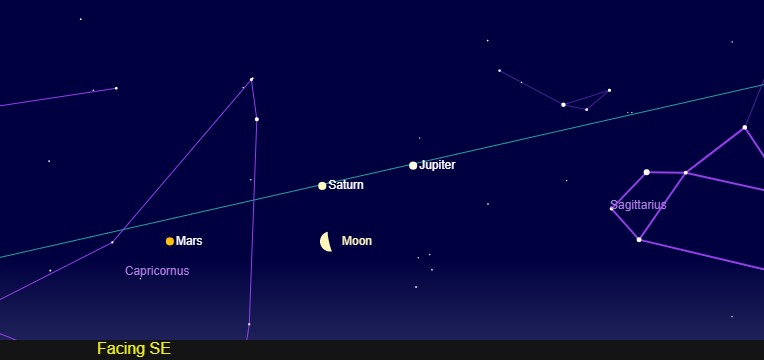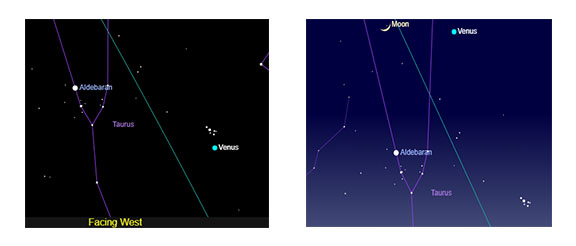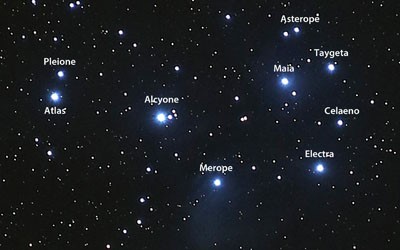Due to the troublesome world all around, many of us these days have to stay home. With a lot of free time available, why not take a look outside on some of these warmer spring evenings and see what is going on in the dome of the sky? There is always a lot to see, whether learning your way around the bright stars and constellations, or focusing on particularly special celestial events.
During April, our three current morning planets are still grouped together. Set your alarm clock for 5:30 am, put on a jacket, and find a spot with a view to the southeast. Jupiter will immediately be obvious to see. Early in April, Mars and Saturn will be very close together, to the left of Jupiter. Which one is which? To me, Mars appears reddish orange, while Saturn is sort of a dull yellow. By the middle of April, the Moon will be passing through the scene, as can be seen in the image below, with Mars having moved quite a bit to the left, and very far by the end of the month. This is due to their never ending race in their orbits around the Sun. Mars is leaving slower moving Jupiter and Saturn behind, while in turn being caught up to by faster Earth. At the start of April, Jupiter will appear about 15 times brighter than almost equal Mars and Saturn. By the end of the month, Mars will noticeably outshine Saturn, on its way to exceeding Jupiter this fall!

View of southeastern sky, April 15, about 5:30 am (Sky & Telescope magazine)
Much more convenient to see is the evening show in the west. Venus and Earth, being relatively close together, have developed a resonance in their orbits, causing our sister planet to orbit the Sun almost exactly thirteen times for every eight times that Earth does. This means that appearances of Venus repeat themselves every eight years, and the one we are in now is just about the best possible from the northern hemisphere. At the peak is a close passage to, or even through the Pleiades star cluster, taking place this year on April 3. Don’t miss it- the next one won’t be until 2028!
Ordinarily, the Pleiades can be easily found by extending the line through the stars of Orion’s belt towards the west, first through the orange star Aldebaran, and then continuing on. At first glance, the Pleiades may appear as a fuzzy cloud to the unaided eye, but a close look shows several stars in a compact dipper shape, sometimes confused with the Little Dipper to the north. A person with average to good eyes might see six individual stars in the Pleiades on a clear dark night- how many can you see? Binoculars show many more.
In Jewish folklore, a male angel named Shemhazai fell to Earth. A maiden by the name of Istehar pledged herself to him, on condition that he tell her the sacred name which gave him the power to fly up to Heaven. However, once he told her, she flew up herself, leaving Shemhazai behind. Both were eventually placed in the Pleiades. To the Greeks, the Pleaides wer e seven sisters, the daughters of Atlas and Pleione. When Atlas was condemned to spend the rest of his days holding up the heavens, the hunter Orion went off in chase of the sisters, who were first changed into swans and then placed in the sky, close together. The eldest daughter, Maia, gave birth to Hermes (Mercury in Roman Mythology), the messenger of the gods. The other sisters also had children with Zeus, Poseidon, and other gods.
As can be seen in the image below, Venus will pass very close to the Pleiades at the beginning of April- closest on the 3rd, but nearby for a couple of days on either side. This will be a great view to the unaided eye or especially in binoculars. You could even try to take a picture, either with a telephoto lens or by holding up a smartphone to a set of binoculars mounted on a tripod. From April 25-27, the Moon will join the scene, with the Pleiades disappearing into the western twilight soon after that.
 View of western sky, about 8:45 pm; April 1 (left) & April 26 (right), (Sky & Telescope magazine)
View of western sky, about 8:45 pm; April 1 (left) & April 26 (right), (Sky & Telescope magazine)Although appearing to be close together early in the month and both representing female mythological figures, Venus and the Pleaides could not be more different. Being a planet, Venus shines brightly because its cloudy atmosphere reflects the Sun’s light very well. It is also usually the nearest planet to Earth. The stars of the Pleiades are young by astronomical standards, having recently condensed out of clouds of gas that can be seen in the image below. They shine a beautiful bluish-white because they are very hot. Maia, for example, is some 850 times more luminous than our Sun.
Why aren’t the Pleaides dazzlingly bright like Venus in our night sky? Like all stars, they are fantastically far away. Venus will be about 60,000,000 miles away from Earth in early April. We can sort of imagine a number like that, but the stars are fantastically far away, so the distance that light travels in a year, or about 6 trillion miles, is the usual means of astronomical measurement. The Pleiades are about 440 light-years away, or about 2,640,000,000,000,000 miles. Or another way of looking at it would be that the light from the Pleiades left around the year 1580, or before telescopes were invented, and is only now arriving at your eyes. Thinking about these things that can be seen in the dome of the sky can be a way of taking your mind off of the troubles of our small planet.

The Seven Sisters (right) with parents Atlas and Pleione to the left.
In Japan, the Pleiades are known as Subaru. The famous logo of
the automaker is based upon the pattern of the six brightest stars.
